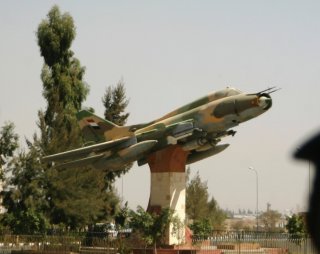In the Afghan War, the Su-17 Was a Soviet Workhorse
The Su-17 did a bit of everything for the Soviets in Afghanistan.
Here's What You Need to Remember: The Su-17 saw significant service in the Soviet war in Afghanistan. It served in many roles during that conflict, including reconnaissance, strike, and minelaying. Combat experience in this conflict led to the fitting of chaff and flare dispensers and additional armor to the aircraft.
For many military watchers, the Sukhoi name is synonymous with the clean flowing lines of the Su-27, Su-30, and Su-35 series of Flanker aircraft or the squat and stubby Su-25 ground attack aircraft. However, during the majority of the Cold War, the swing-wing Su-17 (known as the Su-22 for export) formed the bulk of strike and CAS aircraft for Soviet and Warsaw Pact forces.
Some of these aircraft still fly today in the service of former Soviet allies. The aircraft has seen extensive service in the Syrian Civil War. But how does it stack up to North Atlantic Treaty Organization fighter-bombers of the same era?
The Su-17 was first developed as a follow on to the earlier Su-7B fighter-bomber. The Su-7B was the Soviet Union’s first jet-powered tactical bomber, coming on the heels of the Il-10 piston-powered aircraft.
However, as the Su-7B was an adaptation of the Su-7 fighter, it suffered from insufficient bomb load. When engines were upgraded to handle a higher bomb load, the Su-7B’s takeoff run became too long for most frontal airfields.
The need for heavy bomb loads and short takeoff runs was a problem for many Soviet aircraft of the era. TsAGI, one of the chief aerodynamic research institutes of the Soviet Union came up with two solutions: the addition of disposable rocket or jet thrusters or the use of a variable geometry-wing.
While the Soviets produced some disposable rockets for special purposes, the variable-wing was considered the better solution after some testing. In the mid-1960s, three Soviet aircraft would be accepted into service with the variable-wing: the MiG-23 fighter, the Su-24 strike bomber, and the Su-17 fighter-bomber.
The swing-wing American F-111 entered service around the same time, but in payload, speed, and size it was far larger than the Su-17 and even the Su-24.
Rather, the French/British SEPECAT Jaguar can be seen as the closest NATO analog to the Su-17, although it is a fixed-wing aircraft, not a swing-wing aircraft. Both aircraft can carry around 4000 kilograms of munitions and are single-engine aircraft with similar top speeds.
Both aircraft received precision-guided munition capability around the same time. However, the Su-17 received this capability in two variants, first with the Su-17M3 in 1981 and then with the Su-17M4. The Su-17M3 and M4 featured the “Klen” laser rangefinder and target designator. It was a fairly rudimentary system without a display. Aiming was conducted via a HUD reticle which the pilot pointed at a target. The system would then “lock on” and track the target with a targeting laser.
To contrast, the French Jaguars received the ATLIS targeting pod, a first-generation targeting pod with a laser designator. This integrated with a display in the cockpit so the pilot could “aim” the laser at a target through the display, slewing it on gimbals inside the targeting pod instead of pointing the entire aircraft at the target.
However, the Su-17 featured more hardpoints than the Jaguar. The Su-17 featured two dedicated hardpoints for R-60 air-to-air missiles, in contrast to the Jaguar which shared hardpoints between air-to-air and air-to-ground ordnance. A Su-17 could carry a full bomb load as well as two air-to-air missiles for self-defense, in contrast to the Jaguar which would have to lose some air-to-ground ordnance to carry air-to-air missiles.
The Su-17 saw significant service in the Soviet war in Afghanistan. It served in many roles during that conflict, including reconnaissance, strike, and minelaying. Combat experience in this conflict led to the fitting of chaff and flare dispensers and additional armor to the aircraft.
Su-17s left Russian service alongside their MiG-23BN and MiG-27 counterparts during defense reforms during the 1990s and 2000s as single-engine aircraft were not considered survivable enough for air-to-ground combat. In the role as a close air support aircraft, the double-engined squat Su-25 replaces it. In the role as a faster strike aircraft, the Su-34 replaced the Su-17.
Charlie Gao studied Political and Computer Science at Grinnell College and is a frequent commentator on defense and national security issues. This article is being republished due to reader interest.
Image: Reuters.

